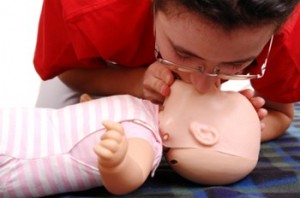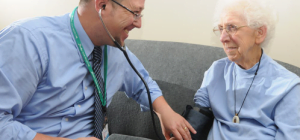 Nobody likes to think about bad things happening, especially to your own child, but not being prepared isn't going to help anybody. Over 90,000 people a year are saved by CPR in the U.S., but many more don't receive the aid they need.
Nobody likes to think about bad things happening, especially to your own child, but not being prepared isn't going to help anybody. Over 90,000 people a year are saved by CPR in the U.S., but many more don't receive the aid they need.
You already know that there is nothing more precious than the life of your child, but how prepared are you in the event of an accident? Hopefully, you'll never need to perform CPR on anyone, but if the situation ever arises, you'll want to know what to do.
The CPR Process
Infant CPR involves identifying and assessing the situation and providing whatever assistance you are qualified for and feel is appropriate. This is in no way intended to provide the proper training to perform CPR, and you should not do so until you are properly trained, but this is something everyone can, and should, learn as soon as possible. It isn't complicated, but like with most simple things, every step matters. So be sure to get the proper training, especially for infant CPR, so you can do everything right in an emergency.
CPR varies depending on the condition of the infant in need of aid. In some instances the heart is still beating but breathing has stopped. In other instances, the heart has stopped as well.
When a child is no longer breathing, aid is performed by making sure the airway is clear and then providing rescue breaths to the child to keep a fresh supply of oxygen in their lungs.
When the child is not breathing and their heart is not beating, it is still necessary to get oxygen into their lungs, but as their heart is not beating, the responder needs to keep oxygenated blood moving through the body to vital organs, particularly the brain.
The instructed method of performing CPR has evolved over time, and continues to be adjusted, but generally consists of a combination of breaths and chest compressions. Rescue breaths involve the person giving CPR to breathe into the mouth of the person needing assistance. This is to get some oxygen into their lungs. Chest compressions involve applying heavy, pulsing pressure to the chest in order to help circulate the infant's blood throughout their body.
Differences between Adult and Infant CPR
The difference between adult, child, and infant CPR involves the ratio of breaths to chest compressions and the depth and technique used for compressions. But beyond the process of CPR, there are differences between assessing the situation surrounding the adults or infants.
Older adults in need of CPR are often suffering from cardiac arrest and the call to 9-1-1 should be immediate because the need for professional help to resuscitate the person is very likely.
Children and infants often need aid because of choking on a foreign object, so responders need to provide extra attention to making sure the airway is clear.
The Importance of Knowing CPR
The American Heart Association estimates that 100,000 to 200,000 lives are lost each year because CPR isn't performed early enough.
Sudden cardiac arrest occurs on average 383,000 times a year outside of a hospital, and in only a third of the cases is CPR performed before an ambulance arrives. A bystander performing CPR until an ambulance arrives doubles the chances of survival, which means that mothers who develop their lifesaving skills can give their children a much greater chance of survival in an emergency.
Hundreds of children a year die from airway obstruction and many more go to the emergency room. Choking on food and toys happens often, but unintentional strangulation and suffocation are also common. Being able to act in these situations can make a huge difference. Many of these accidents happen when children are doing things at the edge of their capabilities, and, although it is best to do whatever possible to prevent these incidents, there's always a chance that it will happen. It's best to be prepared.
The vast majority of accidents happen in the home, so you can't count on others to see what is happening and jump in. You may be the only witness and the only one who can save a loved one. Even if there is someone else who knows how to perform CPR, and is capable, the more people that can assist the better. Performing CPR can be physically demanding over an extended time, and paramedics are seldom on the scene in less than six minutes from when they receive an emergency call. So being able to trade off with another bystander can be invaluable.
Most people carry cellphones with them all the time, so they are never out of reach in case of emergency. However, just because help is on the way doesn't mean it will get there in time. In many places, professional help cannot arrive in time to prevent permanent damage or resuscitate someone. Brain damage is possible within four minutes, likely after six, and brain death is expected after ten minutes if assistance isn't provided.
A population of people well– trained in CPR and first-aid can help each other in our most desperate times to prevent the grief and sorrow that follows when help cannot arrive in time. And as a parent, you have a responsibility to protect your child to the best of your ability. Just a couple hours of CPR training could make the difference for you or another parent, because, as a parent, you'll likely also be around a lot of other children who might one day need help.
Where to Get CPR Instruction
There are several high-quality options for learning to properly perform CPR. The American Red Cross and the American Heart Association provide in-person training. Online instruction can be found at the American Academy of CPR and First Aid. CPR certification is only good for two years, so recertifying is important to protect yourself and provide the best care in emergency situations. The knowledge learned in CPR courses can fade quickly, often within three months, even among those in the medical field, and practices do change, so even if you have been certified before, make sure you're up to date.
John Perkins works as a marketing manager with the American Academy of CPR & First Aid and enjoys writing about topics related to health and wellness. In his free time, he enjoys wake boarding, going to concerts, and cooking with fresh ingredients.







